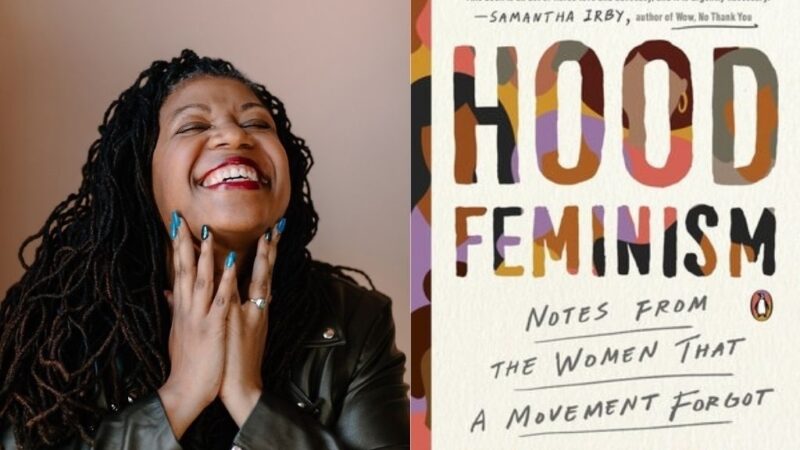PowerHouse Blog
Unequal Pay for Unequal Work
May 10, 2022 | By Kelly Curtis
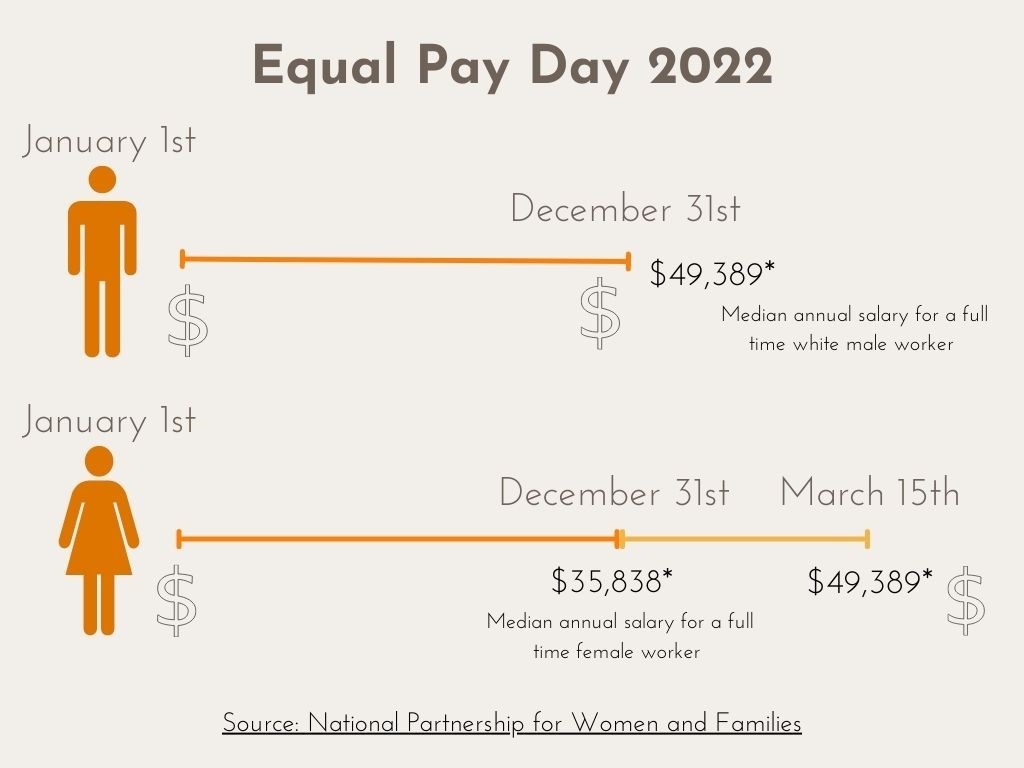
What is Equal Pay Day?
Equal Pay Day was first observed in 1996 at a public awareness event by the National Committee on Pay Equity (NCPE) to illustrate the wide pay gap between what men and women earn. Historically it was called National Pay Inequity Awareness Day and was changed to Equal Pay Day in 1998 (Pay Equity) The date symbolizes how far into the year women must work to earn what men earned in the previous year. The day is also observed on a Tuesday each year to show how far into the next work week women had to work to earn what men earned the previous week. Since it began, Equal Pay Day has looked at data from women’s work earnings across the country to calculate the average amount of money women in the United States earn compared to men (82 cents). These numbers are then broken down further by looking at ethnicity to calculate how race plays a role in women’s financial earnings.
Equal Pay Day symbolizes how far into the year women must work to earn what men earned in the previous year.
How is the gender pay gap calculated?
The gender pay gap is calculated from the median full-time annual earnings of thousands of men and women across hundreds of jobs and job fields rounded to the nearest $100. Because the Covid-19 pandemic pushed so many women into part-time or seasonal work, the 2022 methodology for calculating this data, which historically only looked at women who were working full-time and year-round, includes women who work part-time or seasonally to show how the pandemic has affected women’s work (AAUW).
Data is then aggregated by race which highlights the dramatic differences between what Black, Indigenous, Women of Color (BIWOC) and white women earn which are based on the marginalization of both racial and gender identities. Women who are disabled or part of the LQBTQ+ community also experience additional marginalization, but not all these identities are included in the wage gap data so the level of pay disparity is not as well-documented (American Progress).
Individuals who experience marginalization based on multiple identities experience something called “Intersectional Identities.” Intersectionality was coined by Columbia University law professor, Kimberle Crenshaw, who defined it at a law conference to describe how law frequently failed to keep Black women safe because the law only responded to their identities as Black or as women, not as both. It is this understanding of intersectionality that explains why Equal Pay Day falls in March for women in the U.S. overall but falls at different times throughout the year for Latina, Asian, Native American and Black women.
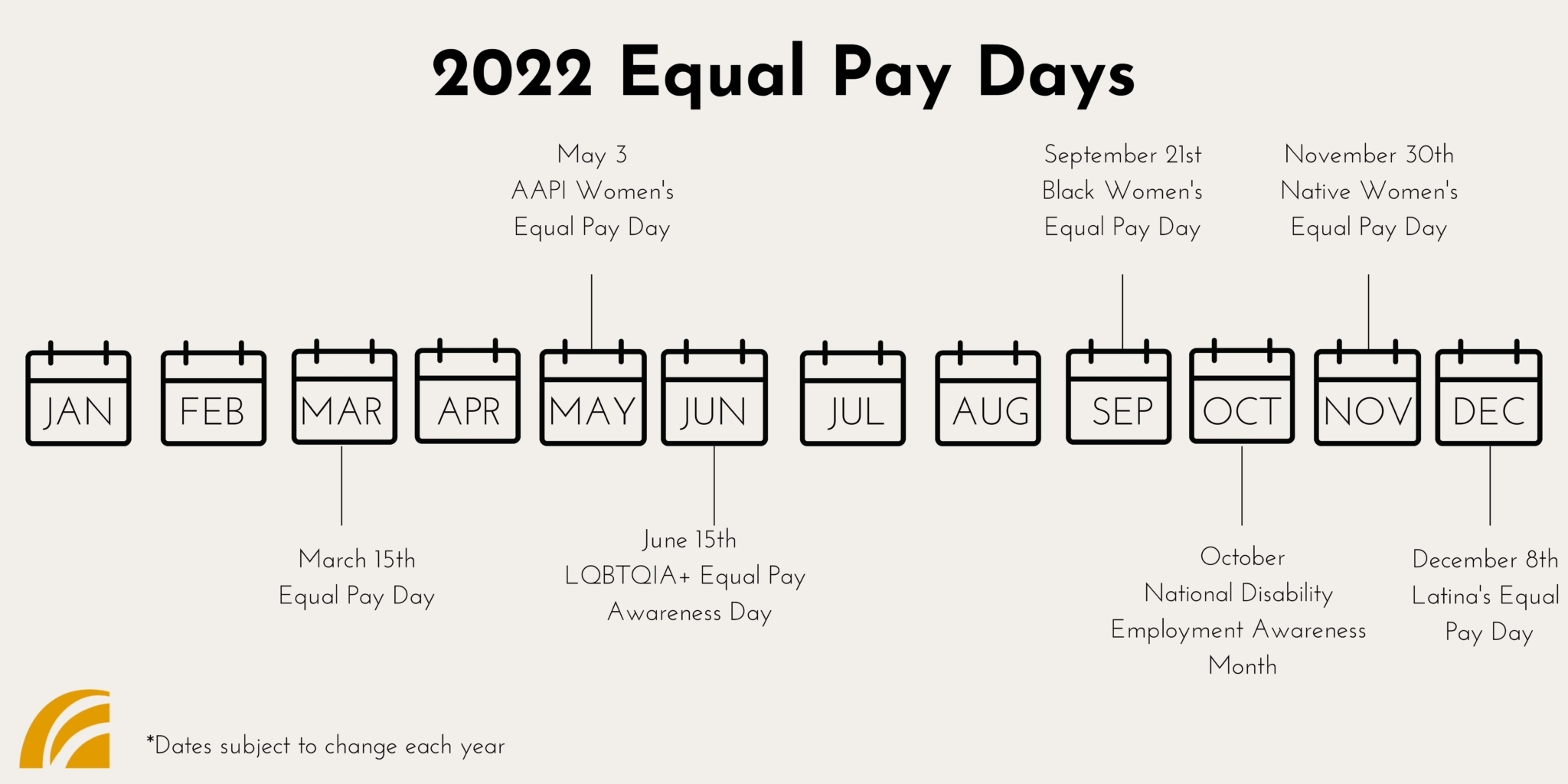
What direct impact does this have on women?
This has a huge impact on women’s retirement and financial stability, especially if they are single parents because women are also frequently targeted by for-profit universities, predatory lenders, and high-interest loans for cars, student debt, and housing. The high cost of maternity care and childcare also leaves women vulnerable to financial setbacks. Childcare is the largest family median income expense and some single mothers can spend about 47% of their income on childcare (American Progress and Montana Government). All of this adds up to astronomical financial losses for American women.
The following visual shows what women could spend on childcare if their incomes per year matched what the average non-Hispanic white man-made in his annual salary. Over a lifetime of lost earnings, the average American woman loses out on $417,400 over the course of a forty-year career. For Black and Latina women the loss is estimated to be $976,800 and $1,156,400, respectively.
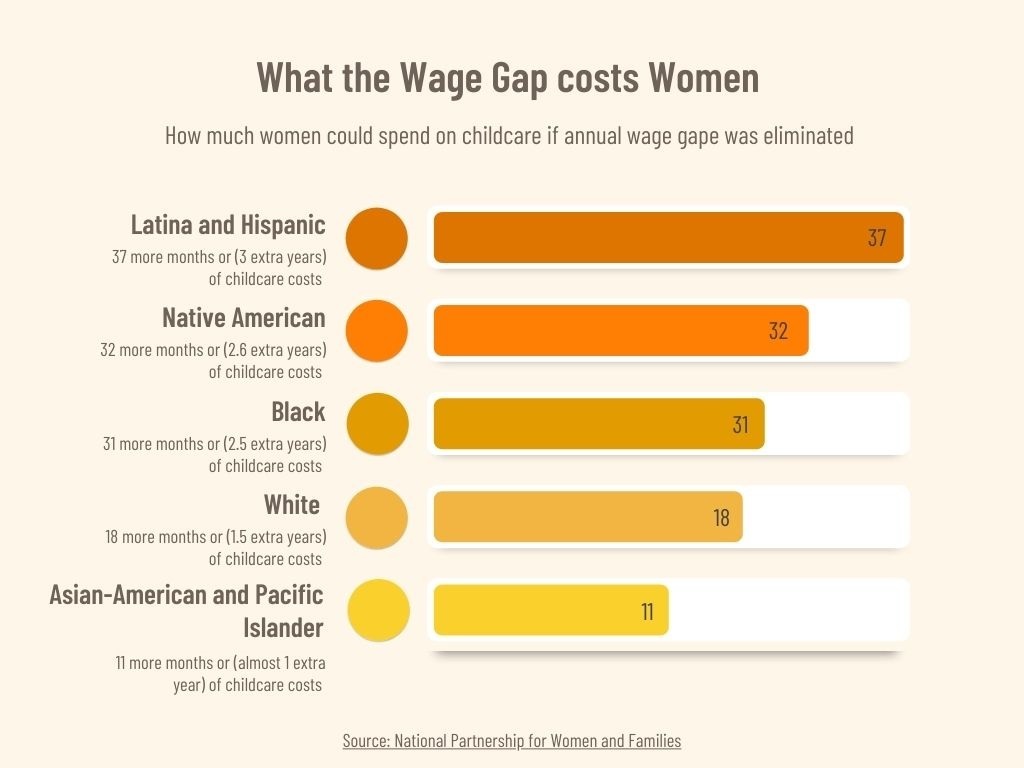
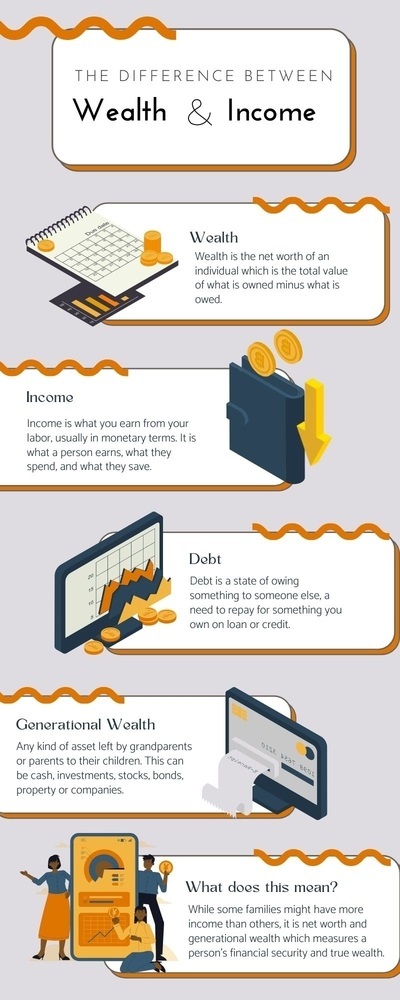
What is income vs. wealth?
The following graphic explains the basic differences between wealth, income, debt, and generational wealth.
With this said, like most social issues in America, understanding the core of both the Equal Pay Gap and the Racial Wealth Gap (which is crucial to closing the gap for women of color) is a lot more complicated.
Netflix’s “Explained” series on the Racial Wealth Gap and the Equal Pay Gap provides a brief but comprehensive overview of these issues. While advocating for pay equity is critical, it’s not the only, nor necessarily the most important, measure of a person’s or family’s financial security. Wealth measures the assets of a family—their savings, real estate, businesses—and subtracts their debt. It's arguably more important than individual income because wealth gets passed on from one generation to the next, determining a person's starting line. It's an often-overlooked indicator, yet it’s an essential building block of the middle class.
Due to a long history of exploitative, dehumanizing, and discriminatory public policies, the wealth gap is much wider for families of color. The wealth gap also grows as people age and is generational. White families are more likely than Black families to receive large gifts or inheritances that can help to pay off student loan debt, build retirement savings, and aid in homeownership- all factors that contribute to wealth over a lifetime and flow from one generation to the next. While income inequality is a factor affecting wealth, income gains have largely been felt in the top tier of income earners in the U.S.
Like most social issues in America, understanding the core of both the Equal Pay Gap and the Racial Wealth Gap (which is crucial to closing the gap for women of color) is a lot more complicated.
What can we do to support women and help close the gap?
Though the 2022 Equal Pay Day came earlier than it has in its 26-year history, women of color actually lost pay (Washington Post) and there is still much progress to be made. The pandemic drastically affected women’s participation in the labor force. Thousands of women were forced or chose to leave because of childcare and eldercare needs. In some reports, the loss is believed to have set women’s labor participation back by 40 years (Forbes). When economists look at the loss of women’s participation, combined with Equal Pay Day moving forward several days, the “improvement” could be attributed to the fact that the wage gap is calculated through the number of full-time female workers, which left out the sheer number of part-time and unemployed women because of the pandemic. Higher earning women had less of a loss in jobs overall and so even with the change in formula calculations this year to include part-time and seasonal work in women, the data is still skewed. It will likely take several more years before the Covid-19 pandemic’s true effect on women’s equity is revealed. In addition, rising inflation on almost all basic goods and the nationwide housing market crisis is hitting women, especially women of color, directly in their wallets.
It will likely take several more years before the Covid-19 pandemic’s true effect on women’s equity is revealed. In addition, rising inflation on almost all basic goods and the nationwide housing market crisis is hitting women, especially women of color, directly in their wallets.
As employers and communities, we can provide better support to women and help narrow the wage gap by:
- Talking about wages in the workplace. Discussing salaries in the workplace is a protected right of all U.S workers (check here for a completed list of exceptions), and is a major way to discover if someone's work is being undervalued.
- Offering the right to unionize.
Those protected under the National Relations Labor Act also have a right to unionize. Women in unions earn on average $212 dollars more per week than women who are not in unions. Women in unions also experience a smaller wage gap collectively than those outside unions. - Banning questions about salary history.
New legislation emerging nationwide is banning employers from asking about salary history, a practice which directly relies on structural bias and most negatively affects women of color. Salary history for women who might have taken time off to raise children, for women of color, disabled women, or women whose last job was in a female-dominated industry (ex. childcare or paid domestic labor), likely does not reflect what a current job should be paid and undervalued initial salaries can drastically affect future earning potential. Montana does not currently have a salary history ban, but here are some states that do.
- Supporting legislation to ban the subminimum wage and the tipped employee wage.
The Fair Labor Standards Act (FLSA) creates standards in which employees of certain identities can be paid at wage rates below the minimum wage. This includes student leaders, and full-time students employed by retail, service, agriculture, or higher education industries. It also includes individuals “whose earning or productive capacity is impaired by a physical or mental disability, including those related to age or injury, for the work to be performed.” (U.S Department of Labor) This means that individuals who work in industries where you are tipped, if you are a part or full-time student (many who support themselves or are adults with children), or have a disability like Down Syndrome, can be legally paid $3 or $4 dollars an hour. The history of tipping is also extremely racist, and in an industry dominated by women, especially women of color, restaurant workers and other service workers shouldn’t have to rely on whether or not they get to tips to “round out” their paycheck. This website has a list tracking legislation to end subminimum wages, of which Montana has no law introduced or passed. - Supporting paid family leave.
Encourage your local legislators to support state and federal policies for paid maternity and paternity leave. As discussed in the "Netflix Explained: Wage Gap" episode, part of the reason that wage gaps in developed countries still exist is based on an overreliance on women’s unpaid domestic labor without proper support. This does not just cover proper pre and postnatal birthing care (although that too is important) but supports mothers by making childcare an equally shared opportunity between parents. In the first year after giving birth, mothers who take paid leave are more likely to stay in the workplace and are 54% more likely to report wage increases than mothers who couldn't access paid leave. Families across America lose an estimated $22.5 billion in wages each year due to inadequate leave or no paid leave (National Partnership for Women and Families). Offering paid leave for fathers on a use-it-or-lose-it basis encourages fathers to take a more active role in the very early stages of their child’s development, and would shift the social narrative of childcare from being a “woman’s role” to the role of both parents. - Employing outcome-based and flexible workplace policies.
Employ flexible work options and a work environment that plays to a wide variety of strengths. Using flexible working hours can help parents who have to drop off and pick up kids from childcare or school during working hours. For some parents, working from home is always going to be easier. For others a hybrid model is best. Offering outcome-based work is better for employees who also may have disabilities or are caretakers of older adults in their life. If an employee can meet their deadlines, then allowing them a flexible model can be extremely helpful for burnout. Some companies offer work with local childcare providers or offer vouchers to help pay for childcare while a parent has to be out of town for a company retreat or work trip. Additionally, encouraging male employees to take leave to help out with childcare or eldercare in their lives will create more equity than having strictly “maternal” based policies. - Understanding the impact of unintended racial and gender bias in the workplace.
Conducting frequent racial and gender bias training is critical in ensuring that both leadership and teams are aware of how they personally bring bias into the workplace, and how that unintentional bias has an effect on their co-workers and their work. Women of color frequently experience microaggressions in the workplace, are tone-policed (often more by white women than by white men), and women everywhere frequently have their performance evaluations focused on their “attitude” or clothing more than their actual work. Along this line, job postings can actually have a great deal of bias which prevents BIPOC individuals and women from applying. A common bias that appears in job positing is the requirement to lift up to 25 lbs. for jobs where that requirement is a non-essential function (think the majority of desk-based work). This “requirement” discourages disabled individuals from applying for a job they would ordinarily be very qualified for. Checking your applications with a fine-toothed comb will ensure you aren’t accidentally turning away qualified applicants from the start.
This Women and the Workplace report 2021 discusses the continuing issues women face in the workplace and is a great conversation starter for how to improve gender equity in companies.


